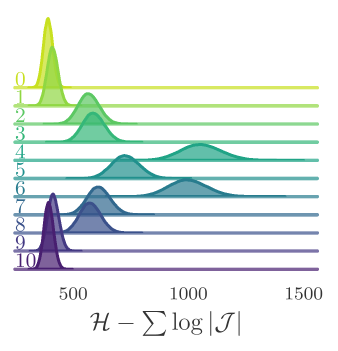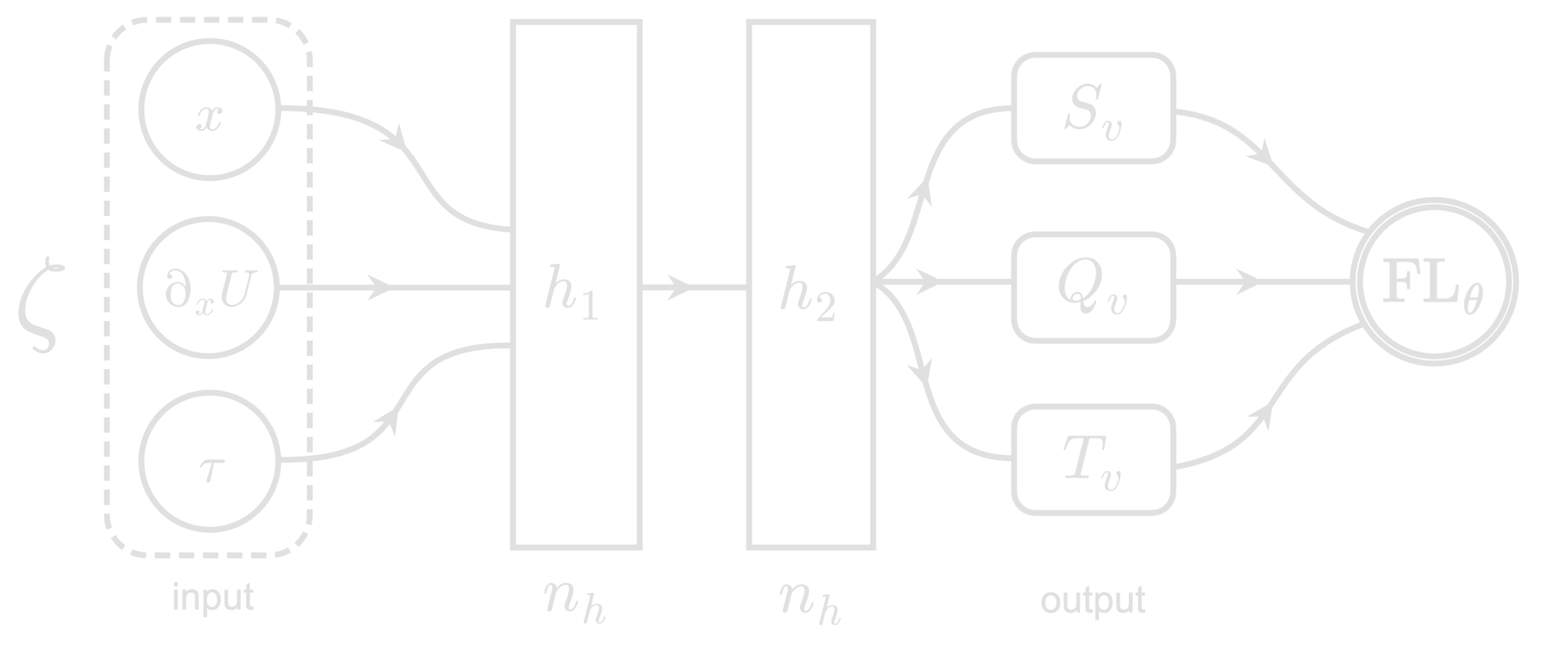Neural Field Transformations
(for lattice gauge theory)
Sam Foreman
2021-03-11



Introduction
-
LatticeQCD:
- Non-perturbative approach to solving the QCD theory of the strong interaction between quarks and gluons
-
Calculations in LatticeQCD proceed in 3 steps:
- Gauge field generation: Use Markov Chain Monte Carlo methods for sampling independent gauge field (gluon) configurations.
- Propagator calculations: Compute how quarks propagate in these fields ("quark propagators")
- Contractions: Method for combining quark propagators into correlation functions and observables.
Markov Chain Monte Carlo (MCMC)
- Goal: Draw independent samples from a target distribution, \(p(x)\)
- Starting from some initial state \(x_{0}\) (randomly chosen), we generate proposal configurations \(x^{\prime}\)
- Use Metropolis-Hastings acceptance criteria
Metropolis-Hastings: Accept/Reject
import numpy as np
def metropolis_hastings(p, steps=1000):
x = 0. # initialize config
samples = np.zeros(steps)
for i in range(steps):
x_prime = x + np.random.randn() # proposed config
if np.random.rand() < p(x_prime) / p(x): # compute A(x'|x)
x = x_prime # accept proposed config
samples[i] = x # accumulate configs
return samples


As
,
Issues with MCMC
- Generate proposal configurations
- \(x^{\prime} = x + \delta\), where \(\delta \sim \mathcal{N}(0, \mathbb{1})\)
dropped configurations
Inefficient!
- Construct chain:
- Account for thermalization ("burn-in"):
- Account for correlations between states ("thinning"):
Hamiltonian Monte Carlo (HMC)
-
Target distribution:
\(p(x)\propto e^{-S(x)}\)
-
Introduce fictitious momentum:
-
Joint target distribution, \(p(x, v)\)
\(p(x, v) = p(x)\cdot p(v) = e^{-S(x)}\cdot e^{-\frac{1}{2}v^{T}v} = e^{-\mathcal{H(x,v)}}\)
-
The joint \((x, v)\) system obeys Hamilton's Equations:
\(v\sim\mathcal{N}(0, 1)\)
\(\dot{x} = \frac{\partial\mathcal{H}}{\partial v}\)
\(\dot{v} = -\frac{\partial\mathcal{H}}{\partial x}\)
\(S(x)\) is the action
(potential energy)
HMC: Leapfrog Integrator
\(\dot{v}=-\frac{\partial\mathcal{H}}{\partial x}\)
\(\dot{x}=\frac{\partial\mathcal{H}}{\partial v}\)
Hamilton's Equations:
2. Full-step position update:
1. Half-step momentum update:
3. Half-step momentum update:
HMC: Issues
-
Cannot easily traverse low-density zones.
-
What do we want in a good sampler?
- Fast mixing
- Fast burn-in
- Mix across energy levels
- Mix between modes
-
Energy levels selected randomly \(\longrightarrow\) slow mixing!
(especially for Lattice QCD)
L2HMC: Generalized Leapfrog
-
Main idea:
- Introduce six auxiliary functions, \((s_{x}, t_{x}, q_{x})\), \((s_{v}, t_{v}, q_{v})\) into the leapfrog updates, which are parameterized by weights \(\theta\) in a neural network.
-
Notation:
-
Introduce a binary direction variable, \(d\sim\mathcal{U}(+,-)\)
- distributed independently of \(x\), \(v\)
- Denote a complete state by \(\xi = (x, v, d)\), with target distribution \(p(\xi)\):
-
Introduce a binary direction variable, \(d\sim\mathcal{U}(+,-)\)
L2HMC: Generalized Leapfrog
- Define (\(v\)-independent): \(\zeta_{v_{k}} \equiv (x_{k}, \partial_{x}S(x_{k}), \tau(k))\)
momentum (\(v_{k}\)) scaling
Gradient \(\partial_{x}S(x_{k})\) scaling
Translation
- Introduce generalized \(v\)-update, \(v^{\prime}_{k} = \Gamma^{+}_{k}(v_{k};\zeta_{v_{k}})\):
- For \(\zeta_{x_{k}} = (x_{k}, v_{k}, \tau(k))\)
- And the generalized \(x\)-update, \(x^{\prime}_{k} = \Lambda^{+}_{k}(x_{k};\zeta_{x_{k}})\)
L2HMC: Generalized Leapfrog
- Complete (generalized) update:
- Half-step momentum update:
- Full-step half-position update:
- Full-step half-position update:
- Half-step momentum update:

Note:
split via \(m^t\)

Network Architecture

(\(\alpha_{s}, \alpha_{q}\) are trainable parameters)
\(x\), \(v\) \(\in \mathbb{R}^{n}\)
\(s_{x}\),\(q_{x}\),\(t_{x}\) \(\in \mathbb{R}^{n}\)
Loss function, \(\mathcal{L}(\theta)\)
- Goal: Maximize "expected squared jump distance" (ESJD), \(A(\xi^{\prime}|\xi)\cdot \delta(\xi^{\prime}, \xi)\):
- Define the "squared jump distance":
where:
Annealing Schedule
- Introduce an annealing schedule during the training phase:
- For \(\|\gamma_{t}\| < 1\), this helps to rescale (shrink) the energy barriers between isolated modes
- Allows our sampler to explore previously inaccessible regions of the target distribution
- Target distribution becomes:
(varied slowly)
\(= \{0.1, 0.2, \ldots, 0.9, 1.0\}\)
(increasing)

L2HMC
HMC


GMM: Autocorrelation

Lattice Gauge Theory
- Link variables:

- Wilson action:
- Topological charge:
(real-valued)
(integer-valued)
Lattice Gauge Theory
- Topological Loss Function:
\(A(\xi^{\prime}|\xi) = \) "acceptance probability"
where:
Lattice Gauge Theory
- Error in the average plaquette, \(\langle\varphi_{P}-\varphi^{*}\rangle\)
- where \(\varphi^{*} = I_{1}(\beta)/I_{0}(\beta)\) is the exact (\(\infty\)-volume) result


leapfrog step
(MD trajectory)







Topological charge history
~ cost / step
continuum limit
Estimate of the Integrated autocorrelation time of \(\mathcal{Q}_{\mathbb{R}}\)

4096
8192
1024
2048
512
Scaling test: Training
\(4096 \sim 1.73\times\)
\(8192 \sim 2.19\times\)
\(1024 \sim 1.04\times\)
\(2048 \sim 1.29\times\)
\(512\sim 1\times\)
Scaling test: Training

Scaling test: Training


\(8192\sim \times\)
4096
1024
2048
512
Scaling test: Inference
L2HMC: Generalized Leapfrog
- Define (\(v\)-independent): \(\zeta_{v_{k}} \equiv (x_{k}, \partial_{x}S(x_{k}), \tau(k))\)
Momentum scaling
Gradient scaling
Translation
- Introduce generalized \(v\)-update, \(\Gamma^{+}_{k}(v_{k};\zeta_{v_{k}})\):
- Define (\(x\)-independent): \(\zeta_{x_{k}} = (x_{k}, v_{k}, \tau(k))\)
- Introduce generalized \(x\)-update, \(\Lambda^{+}_{k}(x_{k};\zeta_{x_{k}})\)
momentum
position
L2HMC: Modified Leapfrog
- Split the position, \(x\), update into two sub-updates:
- Introduce a binary mask \(m^{t} \in\{0, 1\}^{n}\) and its complement \(\bar{m}^{t}\).
- \(m^{t}\) is drawn uniformly from the set of binary vectors satisfying \(\sum_{i=1}^{n}m_{i}^{t} = \lfloor{\frac{n}{2}\rfloor}\) (i.e. half of the entries of \(m^{t}\) are 0 and half are 1.)
- Introduce a binary direction variable \(d \in \{-1, 1\}\), drawn from a uniform distribution.
- Denote the complete augmented state as \(\xi \equiv (x, v, d)\).
(forward direction, \(d = +1\))
Momentum scaling
Gradient scaling
Translation
inputs
L2HMC: Modified Leapfrog
- Writing the action of the new leapfrog integrator as an operator \(\mathbf{L}_{\theta}\), parameterized by \(\theta\).
- Applying this operator \(M\) times successively to \(\xi\):
- The "flip" operator \(\mathbf{F}\) reverses \(d\): \(\mathbf{F}\xi = (x, v, -d)\).
- Write the complete dynamics step as:
(trajectory length)
L2HMC: Accept/Reject
- Fortunately, the Jacobian can be computed efficiently, and only depends on \(S_{x}, S_{v}\) and all the state variables, \(\zeta_{i}\).
- This has the effect of deforming the energy landscape:
- Accept the proposed configuration, \(\xi^{\prime}\) with probability:
- \(A(\xi^{\prime}|\xi) = \min{\left(1, \frac{p(\mathbf{FL}_{\theta}\xi)}{p(\xi)}\left|\frac{\partial\left[\mathbf{FL}\xi\right]}{\partial\xi^{T}}\right|\right)}\)
\(|\mathcal{J}| \neq 1\)
Unlike HMC,


L2HMC: Loss function
Encourages typical moves to be large
Penalizes sampler if unable to move effectively
scale parameter
"distance" between \(\xi, \xi^{\prime}\): \(\delta(\xi, \xi^{\prime}) = \|x - x^{\prime}\|^{2}_{2}\)
-
Idea: MINIMIZE the autocorrelation time (time needed for samples to be independent).
- Done by MAXIMIZING the "distance" traveled by the integrator.
- Note:
\(\delta \times A = \) "expected" distance

MCMC in Lattice QCD
- Generating independent gauge configurations is a MAJOR bottleneck for LatticeQCD.
- As the lattice spacing, \(a \rightarrow 0\), the MCMC updates tend to get stuck in sectors of fixed gauge topology.
- This causes the number of steps needed to adequately sample different topological sectors to increase exponentially.
Critical slowing down!
L2HMC: \(U(1)\) Lattice Gauge Theory
Wilson action:
where:
L2HMC: \(U(1)\) Lattice Gauge Theory
Wilson action:
where:
L2HMC
HMC


L2HMC
HMC


Thanks for listening!
Interested?
github.com/saforem2/l2hmc-qcd
Machine Learning in Lattice QCD
Sam Foreman
02/10/2020

Network Architecture


Build model,
initialize network
Run dynamics, Accept/Reject
Calculate
Backpropagate
Finished
training?
Save trained
model
Run inference
on saved model
Train step
Hamiltonian Monte Carlo (HMC)
- Integrating Hamilton's equations allows us to move far in state space while staying (roughly) on iso-probability contours of \(p(x, v)\)

Integrate \(H(x, v)\):
\(t \longrightarrow t + \varepsilon\)
Project onto target parameter space \(p(x, v) \longrightarrow p(x)\)
\(v \sim p(v)\)
Markov Chain Monte Carlo (MCMC)
- Goal: Generate an ensemble of independent samples drawn from the desired target distribution \(p(x)\).
- This is done using the Metropolis-Hastings accept/reject algorithm:
-
Given:
- Initial distribution, \(\pi_{0}\)
- Proposal distribution, \(q(x^{\prime}|x)\)
-
Update:
- Sample \(x^{\prime} \sim q(\cdot | x)\)
- Accept \(x^{\prime}\) with probability \(A(x^{\prime}|x)\)
if \(q(x^{\prime}|x) = q(x|x^{\prime})\)
HMC: Leapfrog Integrator
- Integrate Hamilton's equations numerically using the leapfrog integrator.
- The leapfrog integrator proceeds in three steps:
Update momenta (half step):
Update position (full step):
Update momenta (half step):
Issues with MCMC
- Need to wait for the chain to "burn in" (become thermalized)
- Nearby configurations on the chain are correlated with each other.
- Multiple steps needed to produce independent samples ("mixing time")
- Measurable via integrated autocorrelation time, \(\tau^{\mathrm{int}}_{\mathcal{O}}\)
- Multiple steps needed to produce independent samples ("mixing time")
Smaller \(\tau^{\mathrm{int}}_{\mathcal{O}}\longrightarrow\) less computational cost!
correlated!




burn-in
L2HMC: Learning to HMC
- L2HMC generalizes HMC by introducing 6 new functions, \(S_{\ell}, T_{\ell}, Q_{\ell}\), for \(\ell = x, v\) into the leapfrog integrator.
- Given an analytically described distribution, L2HMC provides a statistically exact sampler, with highly desirable properties:
- Fast burn-in.
- Fast mixing.
Ideal for lattice QCD due to critical slowing down!
-
Idea: MINIMIZE the autocorrelation time (time needed for samples to be independent).
- Can be done by MAXIMIZING the "distance" traveled by the integrator.
HMC: Leapfrog Integrator
- Write the action of the leapfrog integrator in terms of an operator \(L\), acting on the state \(\xi \equiv (x, v)\):
- The acceptance probability is then given by:
- Introduce a "momentum-flip" operator, \(\mathbf{F}\):
Determinant of the Jacobian, \(\|\mathcal{J}\|\)
(for HMC)
L2HMC: Generalized Leapfrog
- Define (\(v\)-independent): \(\zeta_{v_{k}} \equiv (x_{k}, \partial_{x}S(x_{k}), \tau(k))\)
Momentum scaling
Gradient scaling
Translation
- Introduce generalized \(v\)-update, \(\Gamma^{+}_{k}(v_{k};\zeta_{v_{k}})\):
- For \(\zeta_{x_{k}} = (x_{k}, v_{k}, \tau(k))\)
- And the generalized \(x\)-update, \(\Lambda^{+}_{k}(x_{k};\zeta_{x_{k}})\)
momentum
position








